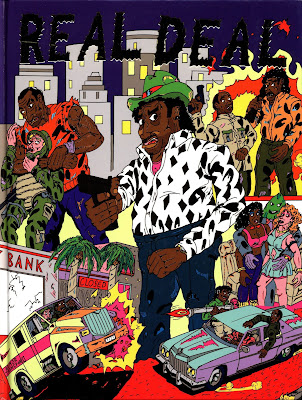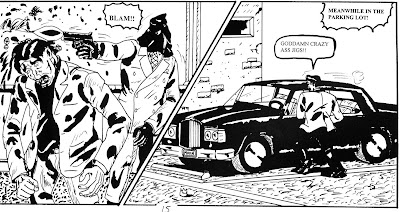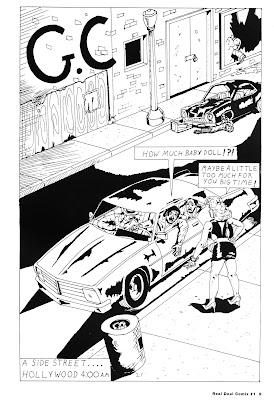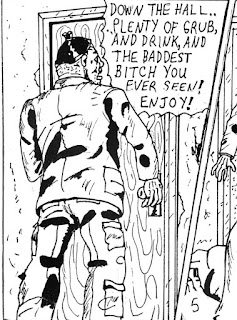Celebrating Black History Month 2019
Real Deal Comix
by Lawrence Hubbard and H. P. McElwee
Fantagraphics, 2016
Here at the PorPor Books Blog we like to celebrate Black History Month by reading and reviewing a fiction or nonfiction book that illuminates the experience of Black America.
For Black History Month 2019, we showcase Real Deal comics. Be warned, though: some people may find this book offensive.
In the late 1980s, two young black men who worked together at the California Savings and Loan building in Los Angeles discovered a mutual love for comics. Lawrence 'Raw Dawg' Hubbard and Harold 'H. P.' McElwee decided to team up and produce their own comic book, one that depicted characters drawn from their observations of street life in L.A.
According to Hubbard, they submitted their prototype first issue to Marvel comics, and got back not a standard-issue rejection letter, but a typed letter that stated that their comic book was 'fucking insane', and 'we loved it', but also, 'Sorry, we can't use it'.
Hubbard and McElwee decided to take advantage of the boom in Indie Comics then taking place and wound up paying out of pocket for the print run of their first issue, which hit the stands in 1990. The reception was favorable enough for the duo to publish another 4 issues of Real Deal by 1996.
In May, 1998 H. R. McElwee, only 43 years old, died of a heart attack. Using scripts written by McElwee before his death, Hubbard went on to publish Real Deal numbers 6 and 7 over the ensuing 19 years. Issue 8 was published in 2018 by Fantagraphics.
I remember seeing issue 2 of Real Deal on the shelves of my indie comics dealer in the early 90s and eagerly reading it cover to cover. Those 1990s issues of the comic offered a lead story featuring 'G.C', a middle-aged black man who dressed in 70s style and had a habit of provoking bloody mayhem at the drop of a pin. The backup stories included 'The R Team', about an all-black commando team that took no prisoners, and 'Planet Dregs', a sci-fi strip.
Hubbard has said that Real Deal is about 'Urban Terror' :
Each story depicts the everyday struggles of the urban dwellers who strike out at each other out of the futility poverty and illiteracy brings them…………..These people live on the edge of a precipice with a kill or be killed foundation.
With the early issues of Real Deal long out of print and fetching steep prices, this Fantagraphics compilation of the first seven issues is a great way to get acquainted with one of the most provocative comics of the 90s. Like everything from Fantagraphics, it's a well-made hardcover book with the comics printed on glossy paper. Along with the contents of each issue of Real Deal, this compilation features reproductions of the color covers; color pinups; and a history of the comic, written by Hubbard.
In keeping with the concept of the 'Real Deal', these are comics that offer no excuses in their depiction of ghetto mayhem. Hubbard and McElwee infuse their tales with graphic violence and the darkest of humor. One panel will have you wincing, the next, laughing out loud.
Accompanying G.C. in his assaults on all comers are D.J. 'Rappin' Sammy; ex-con Chino Bill; G.C.'s homeboy, 'Ace'; and the mysterious 'Hooded Mack'. Providing comic relief is G.C.'s long-suffering wife, 'Poot-Butt'.
Used copies of 'Real Deal Comix' can be found at your usual online retailers for under $20, and brand-new editions for $26.
If you want to see a comic that brings the urban violence of early 1990s L.A. as much to life as the Gangsta Rap of NWA, then you'll want to order a copy.












































































